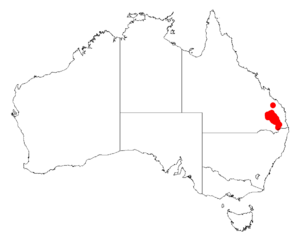Ma Ma Creek wattle facts for kids
Quick facts for kids Ma Ma Creek wattle |
|
|---|---|
| Scientific classification | |
| Genus: |
Acacia
|
| Species: |
loroloba
|
 |
|
| Occurrence data from AVH | |
Acacia loroloba, commonly known as the Ma Ma Creek wattle, is a type of wattle tree. It grows naturally in eastern Australia.
About the Ma Ma Creek Wattle
The Ma Ma Creek wattle is a tree that can grow up to 9 metres (30 ft) tall. Its bark starts out red or green and feels smooth. As the tree gets older, the bark turns grey or brown.
The tree has dark brown, black, or dark blue branches. These branches are smooth, meaning they don't have hairs. When they are young, the branches have clear ridges. The very tips of the young leaves are a pale yellow or golden color and feel soft like velvet.
The leaves themselves are dark green and feel a bit leathery. They grow on a short stalk, about 0.5 to 1.6 cm (0.20 to 0.63 in) long. Each main leaf stem (called a rachis) is about 3.5 to 8 cm (1.4 to 3.1 in) long. It has 10 to 18 pairs of smaller leaf parts (called pinnae). Each of these smaller parts is 1 to 3.5 cm (0.39 to 1.38 in) long. These parts are made up of 14 to 49 pairs of even tiny leaf sections (called pinnules). These tiny sections are narrow and oblong, measuring 1 to 3 mm (0.039 to 0.118 in) long and 0.5 to 0.8 mm (0.020 to 0.031 in) wide.
Flowers and Seed Pods
This wattle tree usually blooms between December and March. Sometimes, it can also bloom between July and August, especially after it rains. Its flowers grow in simple groups called inflorescences. These are often found where the leaves meet the stem.
The flowers are pale yellow and grow in round clusters. Each cluster has about 19 to 23 flowers. After the flowers bloom, usually from August to November, the tree forms seed pods. These pods are brown to black and feel leathery. They are mostly straight on the sides and are about 6 to 14 cm (2.4 to 5.5 in) long and 6 to 9 mm (0.24 to 0.35 in) wide.
Where It Grows
The Ma Ma Creek wattle is found only in south-eastern Queensland, Australia. It is common in the north-eastern Darling Downs region. You can find it from places like Haden and Jandowae in the west. It also grows as far east as Toowoomba and north to Durong.
This tree likes to grow in gently rolling areas. It is often found on flat, fertile land. It grows well in clay or sandy loam soils. You will usually see it as part of open forests or woodlands.

